The piece of the month of May 2015
ALONSO CANO AND JOSÉ RIBERA, INSPIRATIONAL SOURCES IN THE WORK OF LUIS SALVADOR CARMONA: THE MARTYRDOM OF SAINT BARTOLOMÉ DE LEKAROZ
Mª Concepción García Gainza
Chair of Navarrese Heritage and Art
It is already known that the Royal Academy of San Fernando in Madrid cultivated the Spanish imagery tradition and took as model the most important Castilian and Andalusian sculptors and also some painters of the Golden Age, such as Alonso Cano and José de Ribera, as this article tries to demonstrate. This cultivation of the Spanish tradition was done in coexistence and apparently without any conflict with the copying of international models, especially French and Italian.
One of the artists most admired by the academicians was Alonso Cano, considered in the Academy of Fine Arts as one of the main referents of the imagery tradition in his triple condition of sculptor, painter and draftsman. Juan Agustín Ceán Bermúdez himself, author of the famous Diccionario histórico de los más ilustres profesores de Bellas Artes en España, showed himself to be one of the great connoisseurs of the art of Racionero Cano, as well as a collector of his drawings during his years in Seville. It is worth remembering at this point that Ceán Bermúdez himself would choose Alonso Cano as one of his interlocutors in his Dialogues on Sculpture along with Berruguete and Becerra, three artists who combined the triple condition of painters, sculptors and draftsmen.
As we pointed out some time ago, the sculptor Luis Salvador Carmona, sculpture lieutenant of the Academy and the best sculptor of the entire Spanish 18th century, will show in his extensive work his knowledge of the great Castilian sculptors that he knew through training and that would inspire some of his types and approaches of the abundant religious imagery he made. But also his residency program in the Court will make it possible for Luis Salvador Carmona to assimilate the Andalusian sap through the works preserved in the convents and churches of Madrid by sculptors from Granada and Seville, as well as works by various painters. The correct selection of models will allow him to make the synthesis of the Castilian and Andalusian schools, contributing on the other hand, a sensibility typical of the 18th century.
In this context, the influence of Alonso Cano from Granada, already pointed out in a general way in El escultor Luis Salvador Carmona ( 1990), now leaves its clear mark in one of the late and important works of Luis Salvador Carmona. This isthe Christ picking up the tunic after being scourged of the Clerecía de Salamanca, a work signed by the artist and dated 1760. The topic that is represented appears treated with some frequency by Andalusian painters of the seventeenth century, not so much by sculptors dedicated more frequently to the passage of the Flagellation. In the case of Alonso Cano represents the topic in the canvas Cristo Flagelado recoge sus vestiduras (1646) of the Academia de San Fernando, whose drawing (1645) is preserved in the Museo del Prado considered as a study of Cano for the painting in whose composition Salvador Carmona was inspired practically without introducing any variation except the slight turn of head to the front. It depicts Christ after being scourged who, with his hands already released from the column, bends slightly to pick up his tunic that is dragged folded on the ground. The end of the cloth is hanging between the thighs in the Canaesque manner and the nudity is perfect and beautiful like that of his model. The group had been exhibited at the Academy and elsewhere in the Court.

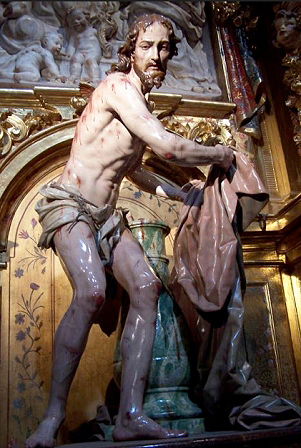
Luis Salvador Carmona, Christ picking up the tunic after being scourged, 1760
Clerecía of Salamanca

Alonso Cano, Scourged Christ picks up his garments, 1646
Royal Academy of Fine Arts of San Fernando
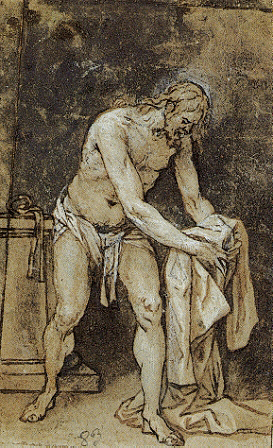
Alonso Cano, The Scourged Christ picks up his garments, 1645
Prado National Museum
Another artist whose imprint can be traced in the sculptor Luis Salvador Carmona is José de Ribera. Specifically the Martyrdom of St. Bartholomew (1756), group central of the main altarpiece of the parish of Lekaroz seems to be inspired by the etching with the same topic signed by Jose de Ribera that is preserved in the National Museum of Capodimonte in Naples of which I have news thanks to R. Fernandez. It has at the bottom the registration: "I dedicate my works and this print to the Serenissimo Principe Philiberto my Lord in Naples year 1624. Jiusepe de Rivera Spañol". The engraving represents the saint naked with his legs bent and leaning on a stone and his arms raised tied with ropes to the branches of the tree on which he is leaning. Saint Bartholomew is being martyred by two sayons on either side. The one on the right pulls the skin off his arm with a knife, leaving the muscle fibers visible. The one on the left is holding objects of martyrdom in his hands. The sculptural group faithfully follows the composition of the engraving except for the saint's crossed legs that replace the bent ones. The bearded head of an old man is directed in both cases to heaven. The sayones perform the martyrdom according to the model simplifying somewhat the complex clothing that allows the effects of etching. The sculptor adds an angel in the upper part of the group .
It is well known that Luis Salvador Carmona used drawings and prints to inspire his sculpture and had at his disposal, in addition to those he had in his workshop, all those used in the Academy, whose Engraving section would soon be put into operation. Another aspect that should be remembered is the presence in his house during the time of his training of his nephew Manuel Salvador Carmona who would become Director of Engraving of the Academy. It is easy to think, therefore, that it was through the Academy that the sculptor Luis Salvador Carmona was able to obtain this splendid engraving by José de Ribera of complex composition and baroque effects; Salvador Carmona repeated this Ribera composition in the disappeared group of the Martyrdom of Saint Bartholomew of the Dominican convent of Valverde de Fuencarral of which Ceán Bermúdez reports "a Saint Bartholomew with two "sayones". We published a photograph of the missing group some time ago.
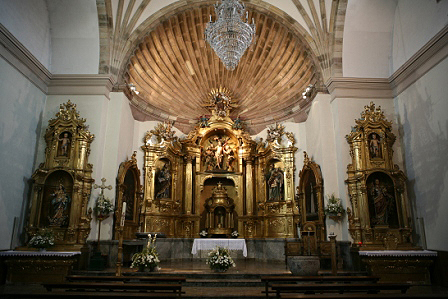
Parish of Lekaroz (Baztan)
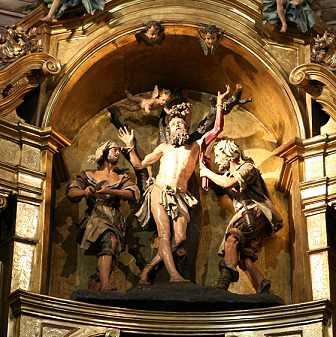
Luis Salvador Carmona, Martyrdom of St. Bartholomew, 1756
Main altarpiece of the parish of Lekaroz (Baztan)
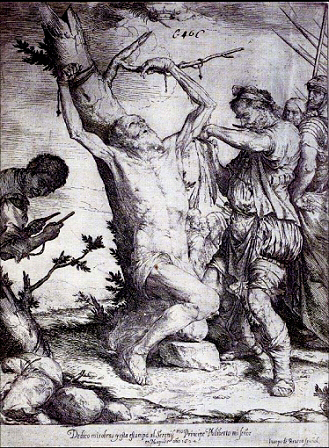
José de Ribera, Martyrdom of St. Bartholomew, 1624
National Museum of Capodimonti

Luis Salvador Carmona, Martyrdom of St. Bartholomew
Church of Nuestra Señora de Valverde de Fuencarral (Madrid)
Both the case of Alonso Cano and José de Ribera, two painters of the Spanish 17th century, expand the chapter of Luis Salvador Carmona's sources of inspiration, from which many surprises can be expected.
bibliography
-CLISON ALDAMA, José, Juan Agustín Ceán Bermúdez, writer and critic of Fine Arts, Oviedo, high school de programs of study Asturianos, 1982.
-PARDO CANALÍS, Enrique, "Los diálogos de Ceán Bermúdez sobre la Escultura en España", Revista de Ideas Estéticas, Madrid, 77, 1962, pp. 351-377.
-GARCÍA GAINZA, María Concepción, El escultor Luis Salvador Carmona, Pamplona, Ediciones Universidad de Navarra, 1990.
-MARTÍN GONZÁLEZ, Juan José, Luis Salvador Carmona. Escultor y Académico, Madrid, publishing house Alpuerto, 1990.
-GARCÍA GAINZA, María Concepción, "Sobre las esculturas de Luis Salvador Carmona en Lekaroz", Cuadernos de la Chair de Patrimonio y Arte Navarro, nº 2, Pamplona, 2008, pp. 243-255.
-WETHEY, Harold E., Alonso Cano painter, sculptor and architect, Madrid, Alianza Forma, 1983.
-SPINOSA, Nicola, Ribera. La obra completa, Madrid, Fundación Arte Hispánico, 2008.
